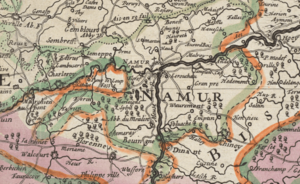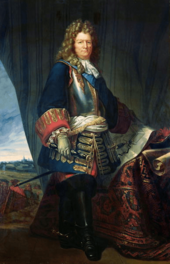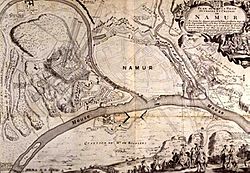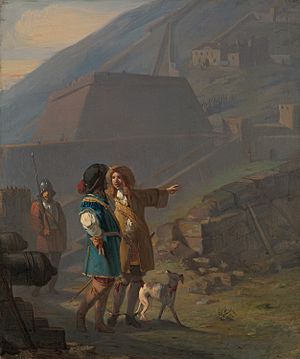Siege of Namur (1692) facts for kids
Quick facts for kids Siege of Namur (1692) |
|||||||
|---|---|---|---|---|---|---|---|
| Part of the Nine Years' War | |||||||
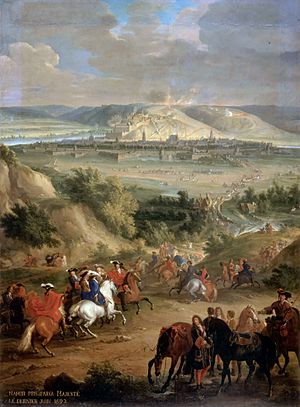 Siege of Namur, June 1692 by Martin Jean-Baptiste le vieux |
|||||||
|
|||||||
| Belligerents | |||||||
| Commanders and leaders | |||||||
| Strength | |||||||
| 120,000 151 guns |
6,000 8,000-9,000 |
||||||
| Casualties and losses | |||||||
| 7,000 killed or wounded | 4,000 killed or wounded | ||||||
The Siege of Namur took place from May 25 to June 30, 1692. It was a big battle during the Nine Years' War. This war involved France fighting against a group of countries called the Grand Alliance.
France wanted to win the war quickly. Capturing Namur was a key part of their plan. Namur was an important city with a strong fortress. It sat where the Meuse and Sambre rivers meet. French forces, led by their famous engineer Vauban, took the town first. This happened on June 5. However, the strong citadel, defended by Menno van Coehoorn, held out longer. It finally gave up on June 30. The siege lasted 36 days.
Afterward, King Louis XIV worried that King William III would try to take Namur back. So, Louis ordered his general, the duc de Luxembourg, to fight the Allies. This led to the bloody Battle of Steenkerque on August 3.
Why Namur Was Important
In 1692, France had five large armies fighting in different areas. But they also created another army just for Flanders. This army's main goal was to attack Namur. Namur was a very important fortress on the Sambre and Meuse rivers.
Taking Namur would give France control of the area. It might also make the Dutch Republic want to make peace. Even if it didn't end the war right away, Namur would be a valuable prize. France could use it in future peace talks.
To stop William III from helping Namur, King Louis XIV had another plan. He arranged for French troops to land in England. They would help King James II try to get his throne back. About 12,000 Irish soldiers and 12,000 French soldiers were ready. But first, France needed to control the sea around England.
The Siege Begins
King Louis XIV left his palace in Versailles on May 10. He traveled to Flanders. French cavalry surrounded Namur on the night of May 25-26. The main French army arrived the next day.
The French army was huge. It was even bigger than the one Louis had used to attack Mons the year before. About 60,000 soldiers and 151 cannons attacked Namur. Another 60,000 soldiers, led by the duc de Luxembourg, watched to stop William III from helping. Namur's defenders had about 6,000 soldiers. They were led by Octavius Ignatius, Prince of Arenberg and Barbançon.
The Town Falls
The Siege of Namur in 1692 was a very important event for King Louis XIV. Two of the greatest military engineers of the time were involved. Vauban led the French attack. The Dutch engineer, Menno van Coehoorn, led the defense of Namur.
Namur was a very challenging place to attack. The town itself was on flat land. But it was surrounded by hills. The citadel, a strong fort, was on a hill between the two rivers. This made it one of the strongest forts in Flanders.
Vauban had secretly explored Namur the year before. He had drawn maps of its defenses. Using these maps, the French built walls around the town. These walls were called "lines of circumvallation." They also set up many large cannon batteries. Trenches for attacking the town opened on the night of May 29-30.
Meanwhile, William III moved his army closer to Namur. Luxembourg moved his army to block William. William hoped to fight Luxembourg, but heavy rain made the river too swollen to cross.
Most of Namur's defenders were Spanish soldiers. They were not very strong or well-equipped. The town did not put up much resistance. It surrendered on June 5. A truce was agreed until June 7. During this time, the defenders moved from the town to the citadel. The French then entered the town. It was also agreed that the Allies would not fire on the town from the hills. And the French would not attack the citadel from the town side.
The Citadel Falls
The Sambre River separates the citadel from the town. The weakest part of the citadel was along the river. But the truce agreement stopped the French from attacking from there. The part of the citadel overlooking the Meuse River was on a rocky, un-attackable hill.
So, the key to taking the citadel was Fort William. This fort was named after William of Orange, who had built it. It was located to the west of the other main strongpoints. The French had to attack from this direction.
The first step was to capture a small fort called La Cachotte. This fort protected the way to Fort William. Trenches were opened on June 8. A big attack with seven battalions of soldiers happened on June 12. La Cachotte fell.
Then, Vauban focused on taking Fort William. Coehoorn himself defended this fort. The fort was well-placed, just over the top of a hill. This hid it from attackers until they were very close. It also protected its walls from cannon fire. French engineers dug tunnels towards the fort from two directions. But recent heavy rain made the work very hard.
Coehoorn showed his determination by ordering his own grave to be dug. This showed he would defend the fort to the end. He was wounded in the head by a cannonball. The final attack on Fort William happened on June 22. Even with Coehoorn's strong defense, he and his 200 men had to surrender.
The next day, Vauban met Coehoorn. Vauban told him he had the "honor of being attacked by the greatest king in the world." Coehoorn replied that his real comfort was making Vauban move his cannons seven times during the attack.
Heavy rain made the roads almost unusable. This made it very hard to bring ammunition to the French cannons. It sometimes took three days to move a single cannon. Wagons could not be used. Cannonballs had to be carried by mules and horses. Without them, nothing would have been possible.
The land around Namur had little food for the animals. The French had to feed their animals leaves and branches. Many animals died. Because of these problems, Vauban asked the King for permission to break their truce. He wanted to attack the citadel from the town side. He felt this would be less shameful than giving up the siege.
However, after Fort William fell, the other defenses did not last long. The citadel finally surrendered on June 30. The remaining defenders left on July 1. This was just in time for the French. Their strength and supplies were almost gone because of the constant rain. The rain had turned everything into mud.
After the Battle
King Louis XIV left Namur on July 2. He arrived back at his palace in Versailles two weeks later. The King ordered special church services to thank God for the victory. But historian John Wolf said Louis might have forgotten his engineers' hard work. Louis wrote that the glory of such a great victory belonged "to God alone."
Even though Louis won a big victory at Namur, his plan to invade England failed. The French navy was defeated at the Battle of La Hogue in early June. This meant France could not control the English Channel. So, the invasion of England was called off. The Irish soldiers went to the Rhineland. The French soldiers joined the army in Flanders or guarded the coast.
General Luxembourg waited for Namur to be made strong again. Then, on July 8, he followed William III towards Nivelles. News reached Versailles that William was planning to take Namur back. King Louis wrote to Luxembourg, telling him to "march with speed... and fight him before he can establish his trenches [before Namur]..."
On August 1, William moved his army. William also wanted to fight. On August 3, he surprised and attacked Luxembourg near Steenkerque village. The battle was not a clear win for either side. Both sides claimed victory. But William left the battlefield to the French. This ended the Allied threat to Namur. Not much else happened in the war before winter.


